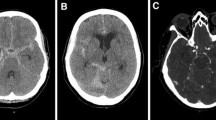Abstract
During the years 1967–1984, 91 children were operated on because of acute compressive traumatic intracranial hematoma; 16 (17%) had traumatic acute subdural hygromas. These were unilateral in 12 cases and bilateral in 4. The causes of injury were traffic accidents in 11 children, a fall in 1, and acute deceleration injuries in 5. Nine children suffered multiple injuries to the thorax, inferior extremities, and pelvis. Clinical manifestations and evolution of clinical symptoms included changes in conscious level, palsy, high fever, nystagmus, maximum dilation of either pupil and spontaneous, irregular breathing. The diagnosis was made on the basis of the clinical picture and supplementary clinical investigations: CT, EEG, echoencephalography, isotope cisternography, and arteriography. Treatment was by simple trephination of the cranium and evacuation of hygromatous liquid. All children survived the surgical treatment; 1 child died after the operation and 2 developed hydrocephalus.
Similar content being viewed by others
References
Anderson H, Elferson J, Svendsen P (1984) External hydrocephalus in fants. Child's Brain 11:398–402
Dandy WE (1945) Hygrome sou-dural chronique et méningite sereuse en “chirurgie du cereau”. Lewis Practice Surg 12:291–294
Dickinson EH (1948) Two cases of acute subdural hygroma simulating massive intracranial hemorrhage. J Neurosurg 5:98–101
Franch BN, Cobb CA, Corkill G, Youmans JR (1978) Delayed evolution of postraumatic subdural hygroma. Surg Neurol 9:145–148
Gitlin D (1955) Pathogenesis of subdural collections of fluid. Pediatrie 16:345–352
Humbert L (1969) L'hydrome sous-dual du grand enfant et de l'adulte. Reflexions à propos de 6 cas. Thèse, Faculte de Medecine, Lyon
Lecuir JM, Lapras C, Mircevski M, Dechaume PJ, Deruty R, Bret P (1973) Problème diagnostic et thérapeutique posés par les hydromes de l'adulte. Report of the 4th Neurosurgical Yugoslavian Congress, Skopje, 1973, pp 720–726
Mircevski M (1974) Neurosurgical contribution of the surgical treatment of subdural hygroma on the basis of 19 cases. Med Facl Skopje 21:429–437
Mircevski M (1975) State of coma as consequence from a traumatic subdural hygroma. Our method. Personal experience. Report of the 5th Congress of the European Neurosurgical Society, Oxford, 1975, pp 192–198 (abstr)
Negoulitch I, Perovich M (1960) Les collections liquidiennes extracérébrales chez l'enfant. Lyon Chir 56:726–739
Savov G (1969) Nevrotraumatologia. Sofia
Todorow S, Haape M (1981) Das traumatische subdurale Hygrom. Ein Beitrag zur Klinik und Pathogenese. Neurochirurgia (Stuttg) 24:131–136
Van Dongen K, Braakman R (1981) Computer tomography in head injury. (Prognosis in neurological surgery, vol 10) Karger, Basel, pp 241–243
Author information
Authors and Affiliations
Rights and permissions
About this article
Cite this article
Mircevski, M., Boyadziev, I., Ruskov, P. et al. Surgical treatment of acute subdural hygroma in children. Child's Nerv Syst 2, 314–316 (1986). https://doi.org/10.1007/BF00271946
Issue Date:
DOI: https://doi.org/10.1007/BF00271946




